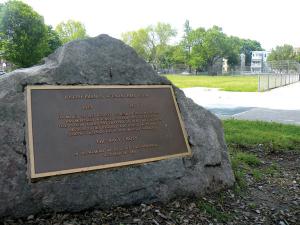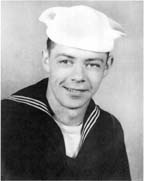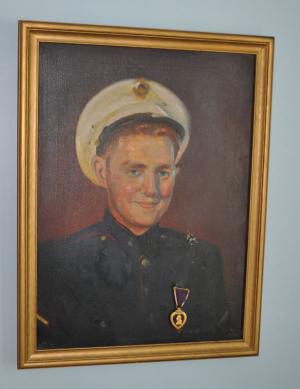May 25, 2011
 A memorial stone to Naval Corpsman Joseph F. Keenan sits in a corner of his boyhood playground, Wainwright/Cronin Park. Just outside the park to the right of the photograph, yards from his home, is Marine Pfc. Allen H. MacQuarrie Square. Photo by Pat Tarantino
A memorial stone to Naval Corpsman Joseph F. Keenan sits in a corner of his boyhood playground, Wainwright/Cronin Park. Just outside the park to the right of the photograph, yards from his home, is Marine Pfc. Allen H. MacQuarrie Square. Photo by Pat Tarantino
Just inside the north entrance to Wainwright/Cronin Park off Melbourne Street in Dorchester there sits a memorial stone dedicated to the memory of 20-year-old Joseph F. Keenan, a Navy hospital corpsman who was killed in Korea in March 1953. Despite wounds that proved fatal, he continued to treat his brothers in the line who had been mauled in an assault by some 3,500 Chinese soldiers.
 Joseph F. Keenan: Navy corpsman was mortally wounded in 1953, but continued treating his wounded comrades.Some 300 feet away, in a line directly west of the Keenan memorial, stands a memorial post noting that the corner of Lithgow and Wainwrights streets is formally named Marine Pfc. Allen H. MacQuarrie Square in honor of the man who was killed in Korea on June 15, 1951, while rushing to the aid of mates who had undergone fierce shelling by a North Korean unit.
Joseph F. Keenan: Navy corpsman was mortally wounded in 1953, but continued treating his wounded comrades.Some 300 feet away, in a line directly west of the Keenan memorial, stands a memorial post noting that the corner of Lithgow and Wainwrights streets is formally named Marine Pfc. Allen H. MacQuarrie Square in honor of the man who was killed in Korea on June 15, 1951, while rushing to the aid of mates who had undergone fierce shelling by a North Korean unit.
The fighting on the Korea peninsula, which began with a North Korean invasion of South Korea in late June 1950, initially was described as a United Nations “police action” by President Harry Truman. But it was a war, and over the years since an armistice brought an end to the fighting in 1953 – and the installation of American forces along the demilitarized zone that are still there in 2011 form – it has been described variously as “the forgotten war” and “the war between the wars” of World War II and Vietnam.
The Korean conflict, during which 36,574 members of the armed services were killed in action, according to the Congressional Research Service, took a heavy toll on Dorchester, which lost 37 men in the fighting, and on the St. Mark’s Parish community, where five residents gave their last full measure of devotion to their country.
When the guns had been stilled, Corporal Dennis P. Sugrue of Samoset Street, who was killed 12 days before Pfc. MacQuarrie, First Lieutenant James F. Sullivan of Kenwood Street (Dec. 1, 1950), and Sergeant First Class Leonard J. Best of Dracut Street (Nov. 29, 1950) had joined HM3 Joe Keenan of Mather Street and Allen MacQuarrie of Wainwright Street on the rolls of their community’s honored dead.
For Joe Keenan’s family, the Navy’s acknowledgement of his undeniable heroism – the Navy Cross, the nation’s second-highest decoration for combat valor – was late in coming, but gratefully received by his five brothers in a moving ceremony on the parade square at the Marine Barracks in Washington on May 14, 1999.
The Navy’s account of what Joe Keenan did as March 25, 1953, turned into March 26 is alive with references to his enduring concern about the lives of others as he was being battered again and again by enemy fire:
“Minutes into his first hellish battle, shrapnel from a nearby blast struck his hand. A fellow corpsman moved to his aid, but Keenan waved him off, directing him to nearby wounded Marines.” … “HM3 Keenan continued his work until another piece of shrapnel found him, this time in the head.” … After receiving some cursory medical care, HM3 Keenan restocked his medical supplies and crossed the dangerous 1,600 yards to his company’s position.” … “Once back with his Marines, HM3 Keenan continued to move in the open and as he found and treated casualties, a nearby explosion blew dirt into his eyes, partially blinding him. He was slowed, but undeterred.”
Soon he had “six to eight wounded under his care.” At that point, two members of his platoon urged him to “fall back to a safer area, pointing out his wounds, his inexperience in combat, and the danger of Chinese patrols. They reported that HM3 Keenan barked at them: “I got a job to do and I’m going to do it.” … “The two Marines flushed HM3 Keenan’s eyes, leaving him to bandage his patients.” … “Sometime between 0230 and 0530 on 27 March 1953, shrapnel struck HM3 Keenan in the head and killed him.”
The Keenans were a tight family and as time went by his brothers decided to find out more about their brother’s untimely death. As they probed Naval files and other resources, Mike Keenan, who had been 13 in 1953, learned that Joe had been nominated for a decoration for heroism on the night he died but that the original nomination papers had been lost in action, too. He decided to do something about the situation and diligently took up the case with Navy brass.
After a six-month investigation into the final day of HM3 Joe Keenan’s life, the nomination of this Wainwright Park boy for the Navy Cross was approved by the Secretary of the Navy. It was time for the Keenan boys to head to Washington.
As to Allen MacQuarrie, Joe Keenan’s buddy on the other side of the park, he, too, risked his life to help others in trouble. On the day of his death, he was safely tucked into a fox hole when he heard the sound of incoming mortar rounds and saw two Marines in the trouble zone. According to the story a fellow Marine told the MacQuarrie family years later, Allen jumped out of his safe haven and rushed over to help his fellows. But the North Korean mortars usually came in two parts, and the second one killed him on the run.
 This portrait of Allen MacQuarrie in Marine regalia, done by a contemporary, Edward Vickers, is a family treasure. Allen’s mother affixed his Purple Heart medal to the art work, saying, “That’s where it belongs.”
This portrait of Allen MacQuarrie in Marine regalia, done by a contemporary, Edward Vickers, is a family treasure. Allen’s mother affixed his Purple Heart medal to the art work, saying, “That’s where it belongs.”
While the sights and sounds of 60 years ago, when the diminutive Charlie Paget monitored the pebble-rich ball park, a basketball court featuring net-less rims, and a stickball court from the red-brick field house, have mostly faded into distant sweet memories, the commemoration of reality – the long-ago time when two “Wainie” regulars went off to fight in a distant land and didn’t come back – will be prominently displayed in this neighborhood’s public space.
Wainwright/Cronin Park will be undergoing a facelift in the near future, and earlier this year, when he learned of these plans, Mike Keenan moved to ensure that the memorial to his hero brother would remain in his boyhood playing space. He wrote to CB/A Landscape Architects, which will be directing the rehab, and received assurance from that firm’s Clara C. Batchelor: “Please be assured that our plans will protect the Joseph F. Keenan Memorial stone and plaque during construction and locate it in a place of honor in the redesigned park.”
And from time to time, flowers will grace the signpost at the adjacent Allen MacQuarrie Square.
Dorchester Roll Call
Below are the Dorchester men who were killed in action during the Korean War:
Richard I. Backoff
Neponset Ave.
Robert W. Bernier
Fuller St.
Leonard J. Best
Dracut St.
Frederick J. Bloom
Woodrow Ave.
Richard G. Boles
Hamilton St.
Mark Connolly
Napier Pk.
Everett L. Copeland
Shawmut Ave.
Francis X. Coppens
Geneva Ave.
Thomas F. Cox
Cedar St.
George A. Cribbie
Granite Ave.
William J. Dowd Jr.
Hancock St.
Harold J. Driscoll
Oakwood St.
Alfred P. Duffy
Dorchester Ave.
Joseph R. Durant
Belton St.
Louis W. Epstein
Havelock St.
John F. Flaherty
Mt. Vernon St.
David T. Gamble
Algonquin St.
Joseph F. Keenan
Mather St.
John H. Kelly
Hamilton St.
John J. Logan Carson St.
Allen H. MacQuarrie
Wainwright St.
John T. Marr
Morrill St.
Richard E. Marsland
Granger St.
Robert A. McClaverty Jr.
Leonard Ct.
Bernard Mitchell
Corona St.
Howard L. Mitchell Jr.
Rosseter St.
Victor H. Rhodes Hancock St.
Herman J. Rosenblatt
Angell St.
Domenic J. Santa Maria
Sylvester Rd.
Henry C. Sharland III
Maples St.
Joseph Slifko Crescent Ave.
James E. Smith Jr.
Elmhurst St.
Theodore J. Smith
Kingsbury St.
Dennis P. Surgue
Samoset St.
James F. Sullivan
Kenwood St.
Bernard J. Walsh
Neponset Ave.
Joseph P. Young
Columbia Rd.


